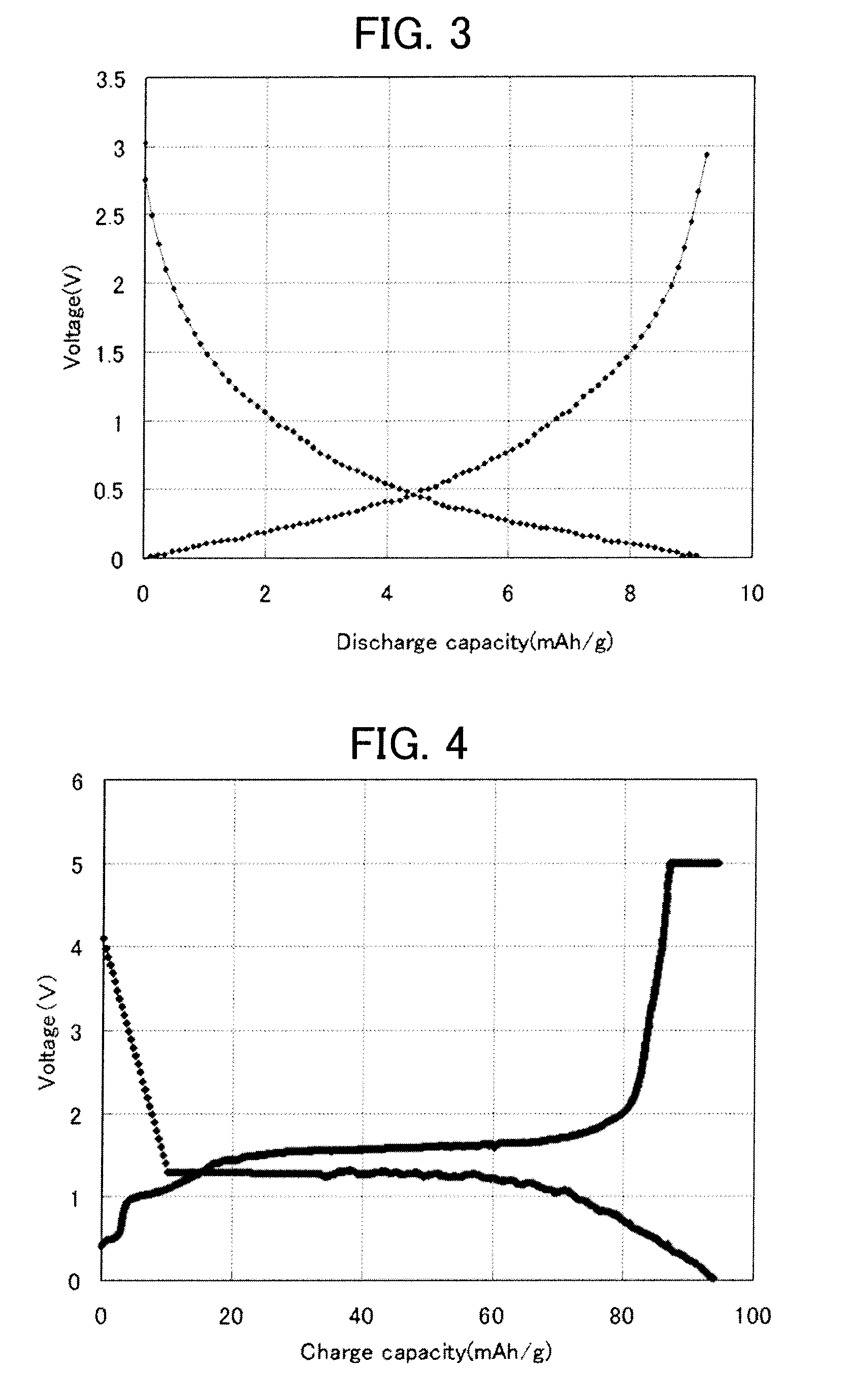All-solid battery and method of manufacturing the same
a technology of all-solid batteries and manufacturing methods, which is applied in sustainable manufacturing/processing, paper/cardboard containers, non-aqueous electrolyte cells, etc., can solve the problems of low charge and discharge efficiency. , to achieve the effect of high current and high charge and discharge efficiency
- Summary
- Abstract
- Description
- Claims
- Application Information
AI Technical Summary
Benefits of technology
Problems solved by technology
Method used
Image
Examples
example 1
Preparation of Electrolyte
[0096]As raw materials, H3PO4, Al(PO3)3, Li2CO3, SiO2 and TiO2 were used. These raw materials were weighed to obtain a composition in mol % on an oxide base having 35.0% P2O5, 7.5% Al2O3, 15.0% Li2O, 38.0% TiO2 and 4.5% SiO2. The raw materials were mixed uniformly and then put into a platinum pot. The raw materials were heated and melted while being stirred in an electric furnace at 1500 degrees Celsius for 4 hours to provide molten glass. Subsequently, the molten glass was dripped into flowing water to obtain flaky glass.
[0097]The flaky glass was crushed by using a laboratory scale jet mill. Subsequently, classification was performed by using a rotary roller made of zirconia to form a powder with an average particle diameter of 20 μm. This powder was further crushed by using a planetary ball mill, an attritor, a bead mill, etc. to obtain a raw glass powder of lithium ion conducting glass ceramics (hereinafter referred to as the raw glass powder) with an av...
example 2
[0113]In order to confirm the effect of the coating layer, confirmation of whether decomposition temperature was increased was performed by mixing and calcining the electrode active material powder, on which a material serving as a coating layer has been coated, and LICGC. Table 3 shows a list of results in a case of coating with carbon, and Table 4 shows a list of results in a case of coating with copper. The decomposition temperature tended to be increased by the presence of the coating layer, and the decomposition reaction of the electrode active material and the solid electrolyte tended to be suppressed by the presence of the coating layer.
[0114]More specifically, the electrode material and LICGC were blended at a mass ratio of 7:3, and were mixed by using a ball mill; and subsequently, a calcination treatment was performed in a pure N2 atmosphere at 800 degrees Celsius, and a TG-DTA analysis was performed. In the treatment to coat the electrode active material powder with carbo...
example 3
Preparation of Lithium Ion Conducting Glass Ceramics Sintered Carrier
[0116]Acrylic resin and a dispersing agent dispersed in water were added to a raw glass powder, and the mixture was stirred in a ball mill for 12 hours to prepare a slurry. In this slurry, the content of glass fine particles was 65.5% by mass, and the content of acrylic resin was 13.5% by mass. This slurry was formed into a sheet with a thickness of 20 μm on a PET film on which a mold release treatment has been performed by way of a doctor blade method, and primary desiccation at 80 degrees Celsius was performed and secondary desiccation at 95 degrees Celsius was further performed to obtain a sheet-like article. 26 pieces of sheet-like articles after exfoliating the PET film were laminated, and were pressurized at 196.1 MPa for 10 minutes by using an isostatic pressing device (CIP) to prepare a dense green sheet.
[0117]The green sheet was cut out into φ59.5 mm, and was calcined at 1,000 degrees Celsius for one hour ...
PUM
| Property | Measurement | Unit |
|---|---|---|
| thickness | aaaaa | aaaaa |
| temperature | aaaaa | aaaaa |
| thickness | aaaaa | aaaaa |
Abstract
Description
Claims
Application Information
 Login to View More
Login to View More - R&D
- Intellectual Property
- Life Sciences
- Materials
- Tech Scout
- Unparalleled Data Quality
- Higher Quality Content
- 60% Fewer Hallucinations
Browse by: Latest US Patents, China's latest patents, Technical Efficacy Thesaurus, Application Domain, Technology Topic, Popular Technical Reports.
© 2025 PatSnap. All rights reserved.Legal|Privacy policy|Modern Slavery Act Transparency Statement|Sitemap|About US| Contact US: help@patsnap.com


